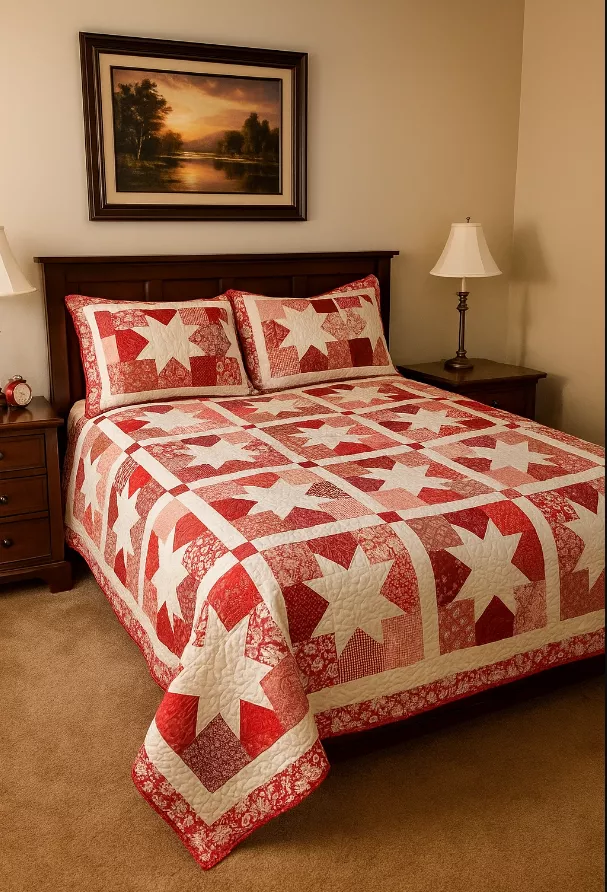The Dutchman’s Puzzle Quilt Block is a classic quilting design known for its simple yet captivating geometric layout. This block dates back centuries and remains a popular choice for its versatility, bold design, and traditional roots. Comprising eight triangles arranged in pairs of flying geese units, the Dutchman’s Puzzle forms a rotating pinwheel pattern, creating a sense of movement and visual interest.
Origins and History of the Dutchman’s Puzzle Block
The Dutchman’s Puzzle block is rooted in traditional American quilting, though its precise origin remains somewhat unclear. Many quilting historians believe it emerged as part of the broader migration of quilting patterns in the 18th and 19th centuries, with early American settlers bringing a range of textile arts, including quilt patterns, across the Atlantic. The name “Dutchman’s Puzzle” is thought to refer to the quilt pattern’s resemblance to windmill blades, which were iconic to the Dutch landscape.
Design Elements and Structure of the Dutchman’s Puzzle Block
- Flying Geese Units: The Dutchman’s Puzzle is built from flying geese units, each made of two smaller right triangles and one larger isosceles triangle. Each pair of flying geese points towards the center, creating a pinwheel shape. This clever use of geometry allows quilters to create a strong, balanced design with a lot of visual movement.
- Eight-Point Star Effect: When pieced together, the block forms an eight-point star-like effect, with each flying geese unit contributing to the appearance of rotation. This layout adds dynamism, especially when contrasting colors are used.
- Versatility in Layouts: The Dutchman’s Puzzle block can be used independently or combined in multiples to create larger quilts. When repeated, the blocks align to create secondary patterns and intricate quilt tops, especially in combination with sashing or different color placements.
Fabric and Color Selection Tips
- High Contrast for Maximum Impact: The beauty of the Dutchman’s Puzzle lies in its contrasting triangles. Using two distinct colors, such as a dark and a light or complementary colors, can make the design pop.
- Scrappy Variation: This pattern works beautifully with scrappy fabrics, where each flying geese unit or triangle is made from a different fabric. This creates a lively, vintage-inspired look.
- Color Gradients: For a more modern look, use gradients of the same color family for a soft, ombré effect. This can give the traditional block a fresh, contemporary feel.
Techniques for Making the Dutchman’s Puzzle Block
- Piecing Flying Geese: Traditional techniques for creating flying geese units involve cutting individual triangles and sewing them together. However, modern methods, such as the no-waste flying geese technique, allow for quicker piecing with fewer fabric scraps.
- Chain Piecing for Efficiency: Since this block requires multiple flying geese units, chain piecing (sewing multiple pieces in a continuous chain without cutting the thread between each unit) can speed up the process.
- Precision Matters: Accurate cutting and piecing are essential, especially when creating multiple blocks, to ensure the triangles align perfectly and the block retains its crisp lines.
Variations on the Dutchman’s Puzzle Block
- Double Dutchman’s Puzzle: By adding a second layer of flying geese units around the original block, quilters can create a double pinwheel effect, enhancing the movement of the design.
- Alternate Layouts: Some variations include rotating the flying geese or changing the color layout to create new shapes and secondary designs when blocks are placed side-by-side.
Tips for Success
- Press Seams Carefully: To prevent bulk and ensure clean lines, press seams open or to one side as you go.
- Consider a Test Block: Making a sample block helps refine color choices and confirms that your cutting and piecing are accurate.
- Experiment with Size: The Dutchman’s Puzzle can be adapted to various block sizes, depending on the scale of your quilt.
The Dutchman’s Puzzle: A Legacy of Tradition
The Dutchman’s Puzzle quilt block has become a staple in both traditional and modern quilting circles, celebrated for its adaptability and visual appeal. Whether made in vintage prints, modern solids, or scrappy assortments, this pattern offers endless possibilities and is a great way to showcase contrast, color theory, and precision piecing.

FREE PATTERN HERE
Compartilhe com os amigos
